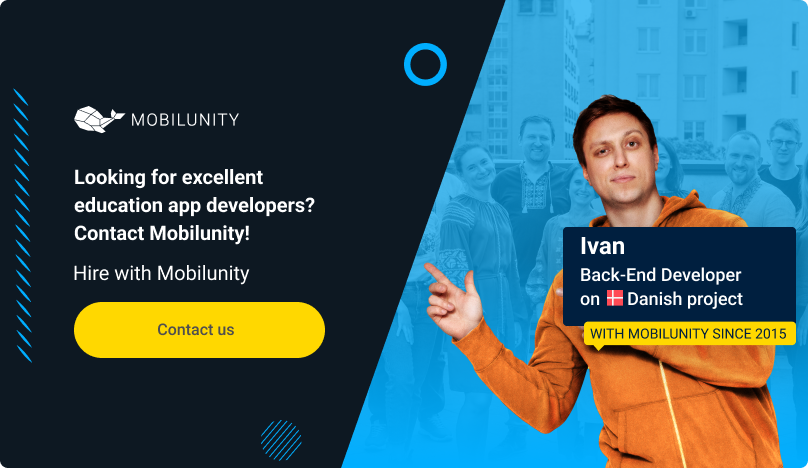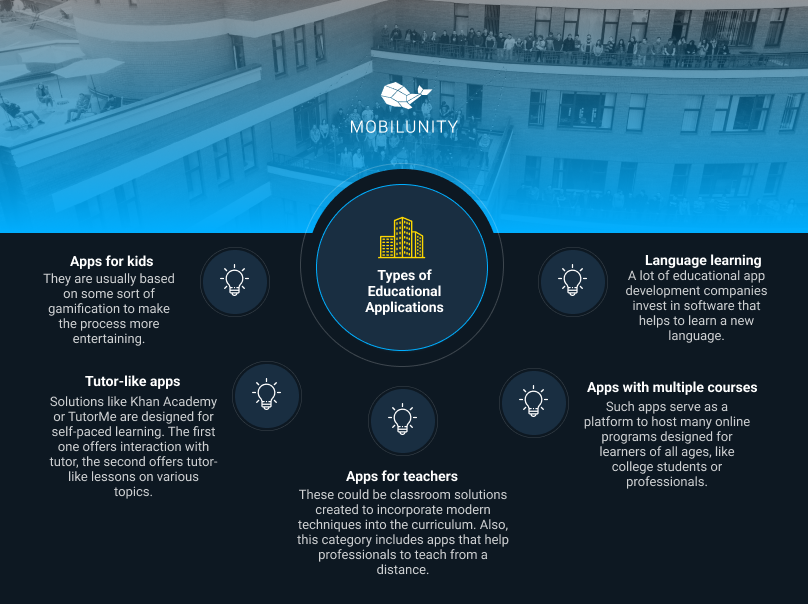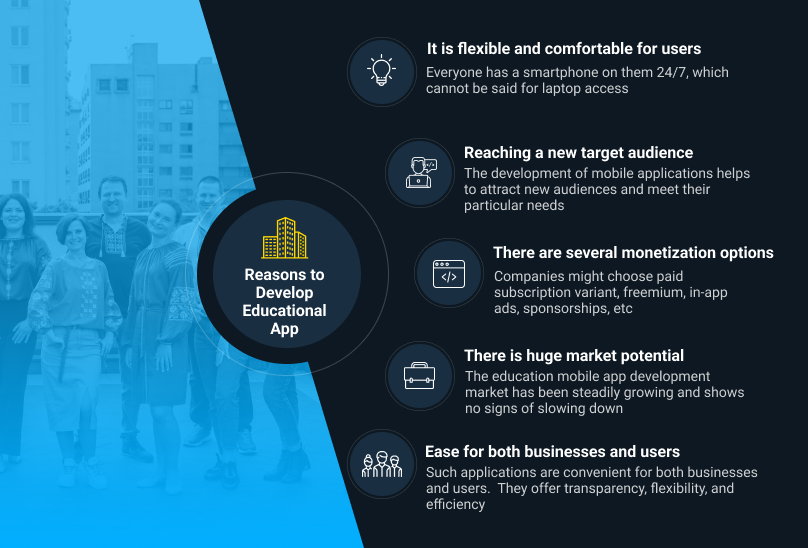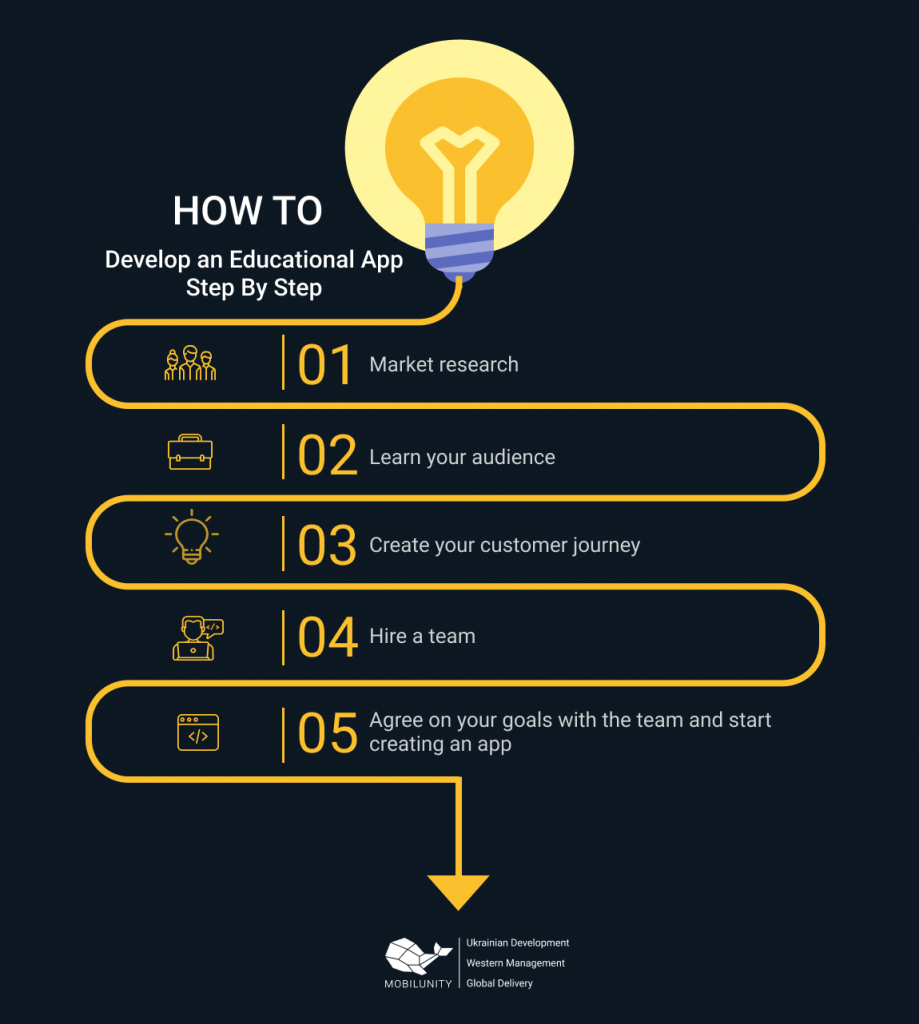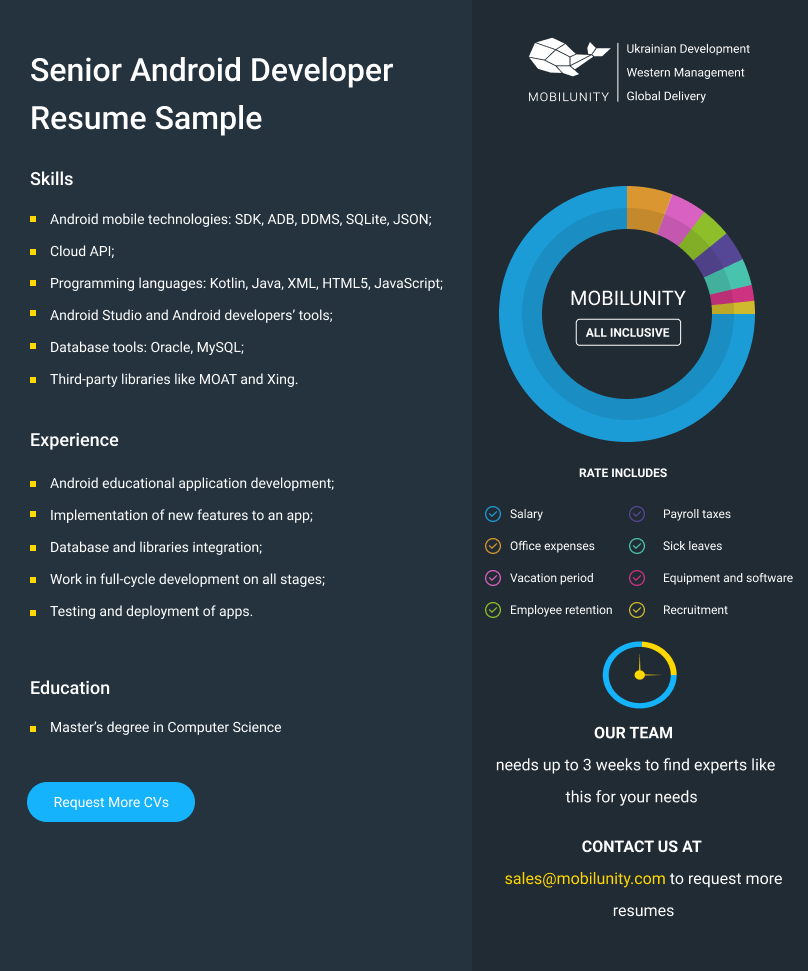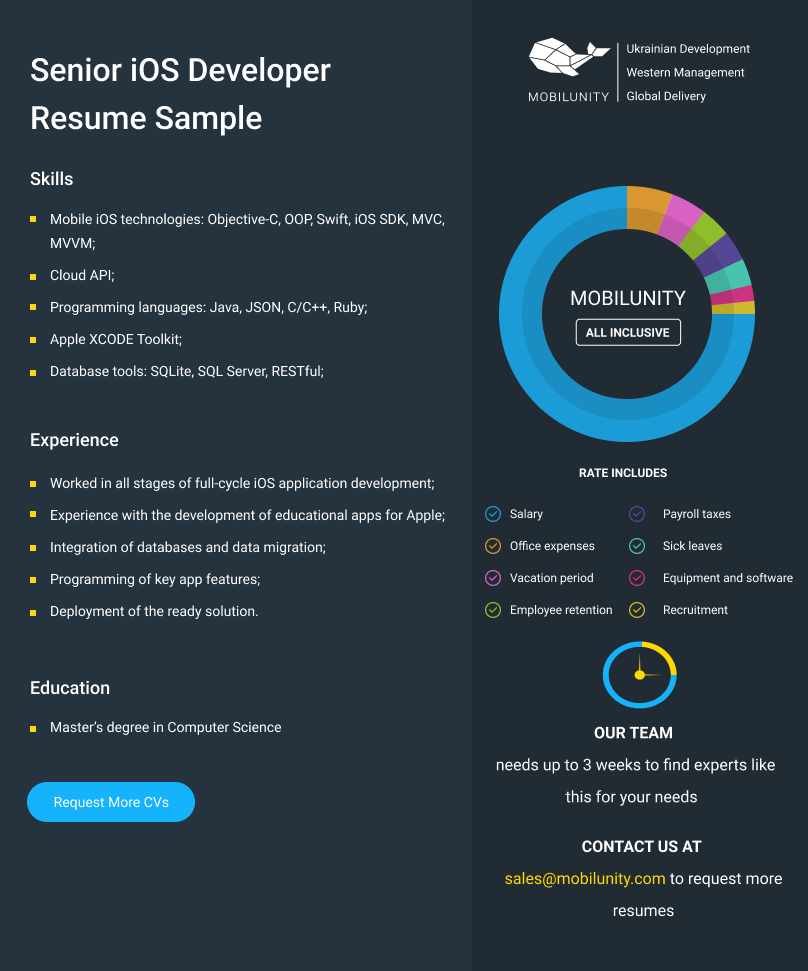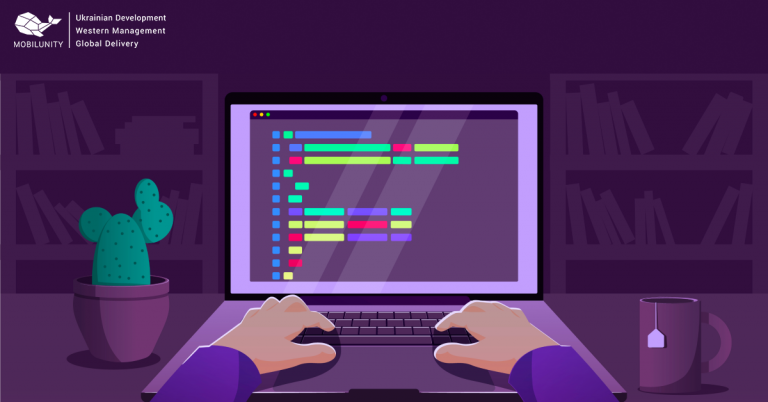Educational App Development: A Guide On Creating Best App For E-Learning

- Types of Educational Applications
- Why Might a Business Need an Educational App?
- Main Features of Modern Education Apps
- Modern Edge Technologies Used to Develop Elearning Apps
- How to Develop an Educational App Step By Step
- EduTech Application Developer Salaries
- Resume Samples for Education Android and iOS Developers
- Mobilunity – Your IT Team Augmentation Partner for Educational Apps Development in Eastern Europe
Although online education has existed for quite some time, the pandemic of 2020 is what gave the industry a major push. Today there are plenty of opportunities to study, collaborate, or even earn a degree completely online.
The eLearning industry refers to all tools and solutions that make this possible, from platforms to mobile applications. This market is forecasted to reach $400 billion worth worldwide by 2026. It is a fast developing source of income a lot of companies have decided to join in. So if you were considering educational app development, this might be just the right time.
According to Statista, educational applications are in third place among the most popular ones in the Apple store in 2022. They are buy-paced only by games and business ones. Another report shows that 81% of college students in the US only think that digital learning tools help them to boost their grades.
All of that data proves immense opportunities for educational mobile app development worldwide. Such solutions are popular among people of different ages, they help to study better and easier, and they are a great source of income for businesses.
So it is not surprising that there is a high demand for expert educational app developers now. If it is something of your interest, this guide will cover all such process inclines, fro, types of solutions to tips on finding suitable development providers. When embarking on educational app development for e-learning, finding objective C developers for hire can be a valuable choice for building robust and compatible apps for the iOS ecosystem.
Types of Educational Applications
Before a business decides to hire education app developers, they need to develop the type of solution they want to create. When it comes to education app development, there are two sorts of software – for teachers and for students.
However, these broad categories do not describe all the opportunities out there. There is a better way to separate the available options.
If you are thinking about educational app development services for your business it would be useful to learn more about its types. It is important because an educational app development cost may depend on it. So we prepared a list of the most popular types with a short description of each. An expert education app development company can create one of the following categories of applications:
- Apps for kids. These solutions are designed with the children’s audience in mind. They are usually based on some sort of gamification to make the process more entertaining. Lessons are presented in the form of games. Kids get to learn while solving puzzles or earning scores. Some of the examples are Poptropica, Fish School, and Quick Math.
- Tutor-like apps. Solutions like Khan Academy or TutorMe are designed for self-paced learning. The first one offers to match with a tutor, the second offers tutor-like lessons on various topics.
- Apps for teachers. These could be classroom solutions created to incorporate modern techniques into the curriculum. Also, this category includes apps that help professionals to teach from a distance. There is an excellent variety of those, from Zoom, which allows easy communication for online classes and up to platforms designed for working with particular groups of students (for instance with learning difficulties).
- Language learning. A lot of educational app development companies invest in software that helps to learn a new language. One of the most well-known examples is DuoLingo – an AI-based application that allows studying a new language from scratch. It includes various features, from short lessons to individualized text to train one’s weak spots.
- Apps with multiple courses. Another prominent segment of education application development is the creation of course-based solutions. Such apps serve as a platform to host many online programs designed for learners of all ages, like college students or professionals. Amazing examples are Coursera and Udemy. There a person can choose the program and study at their pace to practice skills and acquire new knowledge.
- Corporate Training Apps. This type is aimed at training in already existing teams and companies for their members to improve their skill set. And nowadays it is extremely gaining popularity with the development of all modern technologies and online working starting to prevelate. This type can help companies to create a flexible training development platform that will stand to help its employees to improve their knowledge and skills. And the main feature it provides is access wherever and whenever for all corporate members. So this type of educational app development is super comfortable to use and productive in training.
- Employee Engagement Apps. This type is called to engage employees and bring them together. The best employee engagement apps are aimed at increasing communication and support. And for this goal educational mobile app development is the best solution as those apps will be easily accessed and used in everyday life mainly through the mobile devices for the maximum effectiveness.
- E2C eLearning App. An educational app development company can help you even with large-scale projects that provide personalized education like E2C do. These apps are also named education to career. They include a really vaste pool of various functions that are helpful for productive online education. Due to them this type of educational applications can be used for full-fledged education. So if you want to develop an app that will cover all possibly needed functions during the learning process for its higher productivity, this type is definitely for you.
- Virtual Classrooms and Video Conferencing. If you need an app for providing a fully online learning process then this type is for you. This type includes a lot of different features useful in the online education process and help to make it much more comfortable. Video conferencing is helpful for the more effective communication between the teacher and students that is near the real one. Virtual classrooms help publish tasks and other useful materials to make it accessible for all students. So if you need an app that will replace offline education try to find educational app development companies that provide this type of services.
- LMS Development. This type of educational platform development can help to track and manage the whole learning process as it goes from the LMS meaning (learning management system). Thus, it provides such functions as analysis, reports and can make administrative features much easier as well as data collection. So it is such a program that helps online education raise its productivity and effectiveness. One of its main features is facilitated team forming and its members adapting.
- eLearning Apps for Disabled. As now online education is extremely developing and starting to prevelate under the offline education, it requires adapting to all the specifics. That is why now there are more and more apps for students with some kind of disabilities. It is an important part of every educational app as it makes it more adaptable and raises its usability. So if you want to build your own educational app it would be great to pay attention to this side and implement it to your application.
No matter what category you decide on, there are plenty of opportunities on the market to release a new product and gain recognition.
Why Might a Business Need an Educational App?
There are several major benefits such products provide for companies. Why and how to create an educational app for your eLearning business? Let’s start with “why”. Here are the main reasons to consider working on such a product:
- It is flexible and comfortable for users. The main reason why such apps are popular is that they are incredibly convenient for users. Everyone has a smartphone on them 24/7, which cannot be said for laptop access. It is much easier to do a short lesson via a mobile device on the bus, in a queue, or at any spare moment. For an eLearning business, it means growing their audience and number of clients.
- Reaching a new target audience. The development of mobile applications helps to attract new audiences and meet their particular needs. For instance, it is particularly helpful to go global and offer a product people can enjoy anywhere. It diversifies the sources of income as well.
- There are several monetization options. Companies might choose paid subscription variant, freemium (where basic functionality is free and advanced is paid for), in-app ads, sponsorships, etc. And for customers, it is still much more cost-efficient than other educational opportunities.
- There is huge market potential. The education mobile app development market has been steadily growing and shows no signs of slowing down. There is a public demand for simple and effective learning opportunities.
- Such applications are convenient for both businesses and users. They offer transparency, flexibility, and efficiency.
It is only the question of how to make an educational app that serves all user requests and the company’s business goals.
Main Features of Modern Education Apps
With the impetuous development of education apps there also appeared some main features that characterize them and are obligatory to make an app competitive in the market. So we prepared a list of the main features of modern education apps.
- Interface that is easy to use
- Video conferencing
- Audio stream
- Assignments
- Build-in schedule
- Access to the learning materials
- Chat or other form of feedback
- Technical support
- Performance tracker
- Payment form
- Various modern technologies for more comfortable work (AI, gamification)
Modern Edge Technologies Used to Develop Elearning Apps
There are also several technologies used in training for cross platform app development to improve its usability and productivity. Let’s take a look at some of them.
- AI. Artificial intelligence is widely used for app development mainly for improving their users’ experience. AI can help to track reports about a student’s progress or teacher’s experience. These data can be used for improving content and suggestions within the app.
- Big data. This technology is also aimed at tracking different essential details about the learning process from the student’s and teacher’s side, and even parents if necessary. According to it, an app can build an individual learning plan and improve student’s results in such a way. So this technology is important for procuring daily reports and performance tracking within the app.
- Blockchain. This technology integrated in the education apps helps to ensure authenticated convention and security. In such a way it helps to avoid various data threats and other possible problems with cybersecurity. That is why it is a must have in the process of educational app development.
- AR/VR. Augmented Reality/Virtual Reality technology is aimed to improve student’s learning experience making it maximally near to the real one and even better. Thus, for example, it can be used for virtual tours to learn some abstract concepts. It surely makes online education a much better solution!
- Gamification. This can be rather named a technique than a technology as it means a whole concept or approach to the education process. And it implies such a form when learning is provided through the game. In the app it can be implemented as scores, xp, game lives, coins and much more. And it can be a really workable solution not only for young students and children, but for older ones as well.
How to Develop an Educational App Step By Step
How to make education app if you are entirely new to such projects? Here is a step-by-step guide that roadmaps the process.
Step 1. Market research
Begin with market research. Look into what solutions already exist and what features they offer. Consider what audiences or issues might not be addressed by these products. Come up with the idea of how to solve it.
Look for the gaps in the educational apps market. The solution you come up with doesn’t have to be unique, but it needs to have a unique value proposition to the target audience.
Step 2. Learn your audience
Decide on who are going to be the users of this app. Create a profile for a user, including age, interests, location, finances, etc. Depending on the audience, it will have different features. For instance, kids enjoy game-like experiences, students are interested in affordable options, and professionals are looking for flexible and self-paced opportunities.
Learn about the needs of your audience as much as you can so you can meet them.
Step 3. Create your customer journey
Customer journey describes the path a user takes in your application. It also includes the major functions that should be included in the product, such as:
- Login in;
- Profile management;
- Search tool;
- Tracking results;
- Testing;
- Audio or video content;
- Courses;
- Payment options;
- Menu;
- Notifications.
If you create a solution that teachers and students use, you need two customer journeys. For example, if it is an app for matching tutors with learners, they need different functionality.
Step 4. Hire a team
As soon as you are ready with a clear idea of what you are looking for, it is time to find a development team. Many businesses opt for application outsourcing services because it is fast and cost-effective.
Outsourcing app development allows accessing a wider talent pool, saving budget, and getting the best expertise. Usually, an educational app development team consists of such specialists as:
- Project Manager, who oversees and controls the projects as a whole;
- A team of Mobile App Developers (Android/iOS developers) who are going to do the coding;
- Backend developer(s), who are responsible for the server-side of the application and its excellent performance;
- DevOps professional who ensures the optimization and efficiency of the development process;
- UX/UI Designers who design the best user experience and user interface for an app;
- QA engineer who ensures the quality of the product.
Step 5. Agree on your goals with the team and start creating an app
Work with the team on defining goals, deadlines, and objectives. As soon as everything is agreed on, the development begins.
EduTech Application Developer Salaries
How much does it cost to make an educational app? It is a complicated question because the budget depends on many factors, such as the scope of the project, deadline, tech stack, and team salaries.
The rates for freelance mobile app developer differ significantly based on the location of professionals. It is one of the primary reasons why so many businesses opt for outsourcing. It allows hiring excellent professionals at lower rates.
For example, look at this comparison of monthly rates for eLearning app developers in 5 countries.
Android
iOS
*Ukrainian salaries are provided based on Mobilunity’s Recruitment Team research on the local job markets. All salaries are net and do not include the service fee (in case of hiring on a dedicated team model). The salaries are provided for comparison purposes and could be not entirely accurate. Contact us to know the exact cost of hiring a developer corresponding to the required parameters.
Resume Samples for Education Android and iOS Developers
Here are two sample resumes for senior developers to join an educational app development team.
Educational Android App Developer
Education iOS App Developer
Mobilunity – Your IT Team Augmentation Partner for Educational Apps Development in Eastern Europe
Mobilunity is a dedicated dev team provider from Ukraine with over a decade of experience. We offer outsourcing, offshoring, and nearshoring to businesses of all sizes and industries. With the help of our experienced team, you can hire dedicated developers, testers, DevOps engineers, UI/UX designers, or any other IT professionals.
Mobilunity has completed 40+ projects for companies all over the world. We provide access to top talent in Eastern Europe to ensure fast and efficient software development on your terms.
We offer transparent cooperation, quick results, and client satisfaction. Some of our partners are ICUC Social (Canada), 42Matters (Switzerland), FinExpert (Canada), Zenchef (France), and Minedia (Japan).
Our experience allows us to find the right professionals for any project one might have. Whether you need to build a team from scratch or power up your in-house resources with remote employees, we are ready to help.
Interested in educational mobile app development? We know how to help!
Disclaimer: All salaries and prices mentioned within the article are approximate numbers based on the research done by our in-house Marketing Research Team. Please use these numbers as a reference for comparison only. Feel free to use the contact form to inquire on the specific cost of the talent according to your vacancy requirements and chosen model of engagement.
